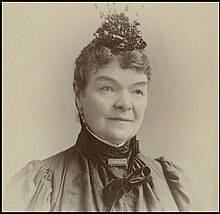Mary Lee (suffragist)
This article needs additional citations for verification. (July 2016) |



Mary Lee (née Walsh) (14 February 1821 – 18 September 1909) was an Irish-Australian suffragist and social reformer in South Australia.
Early life
Mary Lee was born in Ireland at Kilknock Estate, county Monaghan. She was married in 1844 to George Lee. The couple had seven children however little more is known about her life in Ireland. Her son Ben moved to Adelaide, South Australia. When he fell ill in 1879, Lee and her daughter, Evelyn, immigrated to Adelaide as well. They travelled on the maiden voyage of the steamship Orient. Her son died on 2 November 1880.
Australia
In 1883 Mary Lee became active in the ladies' committee of the Social Purity Society. The Society advocated changes to the law relating to the social and legal status of young women, advocating an end to child labour to protect girls from abuse and preventing them from becoming prostitutes or child brides. The group's success was a passage in the 1885 Criminal Law Consolidation Amendment Act that raised the age of consent from 13 to 16. Her first achievement was a new law to protect young women, which made it illegal for a man to have sex with a girl under 16.
The Social Purity Society also was concerned with the working conditions of women. After the bill was passed in 1885 the group began campaigning for workers' rights. In December 1889 at a public meeting Lee proposed the formation of a women's trade union. The Working Women's Trades Union was founded in 1890, Mary Lee was the union's secretary for two years. In 1893 Lee attended the Trades and Labor Council meetings, served on the sub-committee which examined conditions in the clothing industry, and on the Distressed Women and Children's Committee which distributed clothes and food to the families hit by the economic depression of the '90s.
On 13 July 1888 Lee, the Social Purity League, and others met and formed the South Australian Women's Suffrage League. She was the League's co-honorary secretary and for six and half years she fought for women's suffrage. Her own letters and reports of her speeches show that she was an astute and logical woman, employing sound argument, wit and humour in her correspondence and public speaking. In 1889 she wrote:
Let husbands, brothers, fathers, be kept in mind that it is the duty of every free man to leave his daughters as free as his sons. -as women assist in maintaining Government they have a right to a say how and by whom they shall be governed. Nineteenth century civilisation has accorded to women the same political status as to the idiot and the criminal. Such is the basis of our reverence for the person of women and of our estimate of her work.
Lee was active in advocating the rights of the working class, publishing the following thoughts in The Barrier Miner in respect of the 1892 Broken Hill miners' strike:
... Sir, this strike has one feature which renders it more profoundly interesting than any of its predecessors...which must secure it a prominent and distinguished page when the history of these colonies shall be written. It is that the women of Broken Hill are the first great body of working women who have raised their voices in united protest against the glaring injustice that ‘the present constitution will not allow them a voice in framing the laws ...'[1]
Bills to grant women's suffrage were put forth in the South Australian parliament between 1889 and 1893, all failed. Spurred on by the grant of women's suffrage in New Zealand, Lee, the Social Purity League, the Woman's Christian Temperance Union and the Democratic League travelled all over South Australia, which included the Northern Territory at the time, collecting signatures on a petition. On 23 August 1894 when the Adult Suffrage Bill was read in the South Australian parliament, the women presented the great petition. The petition contained 11,600 signatures, on paper sheets from all over the colony, that had been pasted together to make a roll 122 metres long. The bill passed on 18 December 1894, it granted women the right to vote and stand for parliament, and South Australia was the first legislation worldwide to do so.
Once women had the vote, Lee was active in voter education, encouraging women to enrol and vote. By her 75th birthday 60,000 women had enrolled to vote. In 1885 she was nominated to stand for parliament but refused.
She was appointed to the honorary position of the only female official visitor to the Lunatic Asylums in 1896. During this latter part of her life, Lee struggled financially and had to sell her library. She continued to correspond with women in other Australian states where suffrage was not yet granted.
She died in 1909 from pleurisy following influenza and was buried with her son Ben.
References
- ^ Bloodworth, S. (1996) The Rebel Women of Broken Hill in Militant Spirits, La Trobe University, Melbourne.
- Mansutti, E. 1994. Mary Lee (1821 -1909), State Library of South Australia
